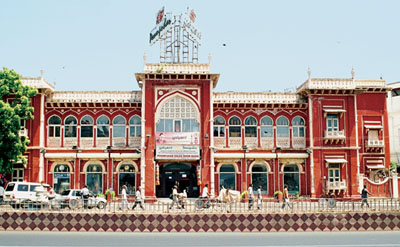|
It was only in the last issue of Madras Musings that we had reported that the Metro Rail route is likely to be a threat to several heritage buildings and precincts: among others the Poompuhar building and its annexe, the Government Press, Higginbotham’s, St Andrew’s Kirk and, temporarily, while the work is going on, May Day Park as well. Subsequent to this, it is learnt, members of the Chennai Chapter of the Indian National Trust for Arts and Cultural Heritage (INTACH) met the Managing Director and senior officers of Metro Rail Limited to express their concerns over the threats to heritage buildings and precincts.

The Poompuhor showroom may not be under threat, but the precinct behind it with heritage Government buildings may well be, unless the Metro Rail does
a re-think. |
It is reliably learnt that Metro Rail has expressed its sympathy with the concerns and sentiments expressed by INTACH and has assured its members that it will take the utmost care to ensure that the heritage structures and precincts will not be affected. To illustrate this point, the officials cited the case of St Andrew’s Kirk where, based on representations from the members of the Church, IIT Madras was called in to do a study on the impact of vibrations during the construction of Metro Rail. IIT had recommended the shifting of the underground tunnel to 45 metres from the foundations of the Kirk while the earlier route was 25 metres away. This, Metro Rail confirms, will protect the Kirk’s unique well foundation from damage during the construction of the tunnel. But, and this is what is most worrying, they are silent on the question of whether the subsequent operation of the underground rail network will in any way affect the Kirk in the long run. There is the same concern in the case of the Poompuhar premises too. Metro Rail confirms that the best equipment will be used in construction and vibration detectors will be employed to ensure that Poompuhar and its neighbour, Higginbotham’s, will not be affected. But, as for the long run concerns, there is no clear assurance on their safety.
INTACH members had, we learn, also raised the point that the Government Press too at the rear of Poompuhar is an integral part of the complex and deserves to be protected for the simple reason that it is at least 100 years old and demolishing it will mean the city loses an important part of its heritage. At this point in time, this pleading appears to cut no ice with the authorities who are of the view that the structure is dilapidated and could well collapse on its own one of these days. They are missing the wood for the trees. They don’t realise that whether it collapses on its own or is brought down, it will erase something that can never be brought back – something from the city’s past, something that needs to be protected and passed on to subsequent generations, no matter how dilapidated it is said to be. In a city that is rapidly losing its built heritage, every structure counts. In fact, the Metro Rail should volunteer to restore such dilapidated buildings as a civic duty. But all that Metro Rail has to say is that this is the best place for the Metro Station on Mount Road and, therefore, the Press’ building has to go.
As for May Day Park, while Metro Rail has all along been maintaining that it will restore the park to all its glory once the work is completed, we understand that it emerged during the meeting that the authorities had no clear plan as to how and where the commemorative stones and the statue of Justice Boddam, together with its ornamental canopy, would be stored while the park is used as a storage space for materials to be used for laying the line. In fact, it appeared that the authorities were not even aware of what specific objects were present in the park or their significance. Bodddam, for instance, had made significant contributions to Muslims’ welfare and uplift in the city. It would appear that scant regard was paid to such aspects when the decision to take over the park was arrived at.
Lastly, we learn that from the route plan that Metro Rail showed INTACH members, it was clear that buildings on Esplanade Road – like Raja Annamalai Manram, the South India Chamber of Commerce and also the Law College – are likely to bear the brunt during the construction. The station will be located under the ground on this stretch which means plenty of digging and, of course, dislocation, drilling and debris. Can these buildings take it all? Metro Rail feels that they can and for this it cites as proof work that has happened in places such as Singapore and Hong Kong. What it does not realise is that most buildings in those cities are modern ones, built with the latest technology and designed to withstand vibrations. Can old buildings cope the same way?
|